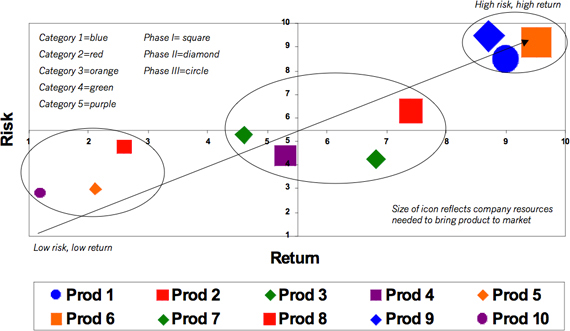The Portfolio Challenge
Perhaps the most difficult challenge facing pharmaceutical and biotech companies in today’s marketplace is how to assemble, manage and maintain product portfolios that satisfy short-term revenue and share goals while addressing long-term strategic interests and objectives.
Pipeline and in-line products present ever changing opportunities and risks and companies need on-going, well-organized teams to evaluate these opportunities and risks using methods that are rigorous, systematic and insightful.
Companies also need to effectively communicate their portfolio goals, successes and failures to their shareholders and stakeholders on a regular basis as perceptions of portfolio strengths and weaknesses can impact industry standing and stock price.
How would you evaluate this new product portfolio?
Where would you invest? Where would you divest?

The SZF Solution
Whether looking at portfolio risk as the interplay of product, category, company and industry risk or simulating new products and seeing how they impact your current portfolio, the SZF Portfolio Tool Kit offers fresh perspectives and actionable insights into the field of portfolio management.
The Tool Kit consists of ten fully integrated modules designed to help you construct and manage your product portfolio for long-term profitability and maximum return on investment.
The ten research modules are:
- Assessing Your Portfolio Management Team
- Analyzing Risk
- Describing Your Portfolio
- Building And Managing Your Portfolio
- Evaluating Your Portfolio
- Evaluating New Products
- Evaluating Your Commercialization Capabilities
- Company Imaging
- Portfolio Positioning
- Portfolio Messaging
These modules will help you:
- Identify and quantify internal and external sources of portfolio risk
- Analyze your current product portfolio in terms of productivity and risk
- Assess the impact of adding products to or subtracting products from your current portfolio
- Analyze your competitors’ current portfolios in terms of productivity and risk
- Assess the impact of your competitors adding products to or subtracting products from their current portfolios
- Evaluate new products developed internally from a portfolio perspective
- Evaluate new products licensed or acquired from the outside from a portfolio perspective
- Assess your company’s internal capabilities for commercializing new products
- Review your company’s image as a reflection of its portfolio’s strengths and weaknesses
- Help craft a portfolio positioning statement
- Help craft a portfolio marketing message
The SZF Process
The ten Tool Kit modules form the core of a larger four stage, step-by-step portfolio review process. The entire process is covered in a series of team workshops and pre-workshop research tasks. If you work with portfolio teams that are process-oriented, the Tool Kit’s workshop format will be especially interesting and appealing to you.
- Stage One
- Assemble portfolio team
- Define research objectives
- Set performance goals
- Identify analytic dimensions
- Customize research tasks
- Stage Two
- Conduct personal and group interviews
- Complete worksheets and grid exercises
- Analyze initial data
- Stage Three
- Present and discuss initial findings with team
- Incorporate comments and revise models
- Stage Four
- Review revised findings with team
- Come to consensus about findings
- Delineate near and long-term portfolio strategy
- Set new performance goals
- Craft portfolio positioning statements for internal and external audiences
- Craft portfolio marketing messages for internal and external audiences
Each module generates qualitative and quantitative data that drive team discussion and evidence-based decision making. The modules employ a variety of sophisticated techniques to develop and analyze primary research data unique to your company and its product portfolio.
These techniques include:
- Qualitative probing and laddering
- Rankings, ratings and constant sums
- Means, standard deviations and indices
- Gap analysis
- Factor analysis
- Cluster analysis
- Perceptual mapping
- Regression modeling
- Conjoint analysis
- Constant sum decision trees
- DCF-ROI analysis (Discounted Cash Flow – Return on Investment)
 New at SZFMission
LeadershipProducts & ServicesClientsBiosContact
New at SZFMission
LeadershipProducts & ServicesClientsBiosContact

